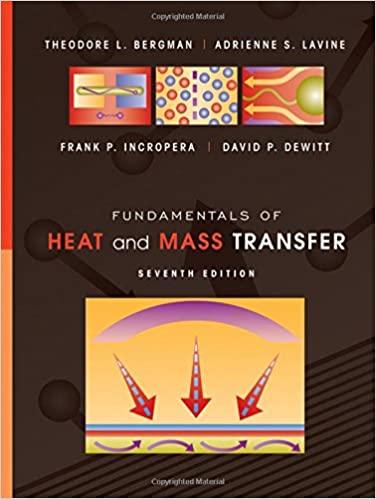The porosity of a packed bed can be decreased by vibrating the containment vessel as the vessel
Question:
The porosity of a packed bed can be decreased by vibrating the containment vessel as the vessel is filled with the particles. The vibration promotes particle settling.
(a) Consider the air chilling process of Problem 7.110a. Determine the outlet air temperature To and mass rate at which the PCM is melted for ε = 0.30. Assume the total mass of PCM and the mass flow rate of air are unchanged. The length of the containment vessel Lv is decreased to compensate for the reduced porosity.
(b) Determine To and the PCM melting rate for the case where the diameter of the containment vessel Dv is decreased to compensate for the reduced porosity. Which containment vessel configuration is preferred?
Data From Problem 7.110
Latent heat capsules consist of a thin-walled spherical shell within which a solid-liquid, phase-change material (PCM) of melting point Tmp and latent heat of fusion hsf is enclosed. As shown schematically, the capsules may be packed in a cylindrical vessel through which there is fluid flow. If the PCM is in its solid state and Tmp < Ti, heat is transferred from the fluid to the capsules and latent energy is stored in the PCM as it melts. Conversely, if the PCM is a liquid and Tmp > Ti, energy is released from the PCM as it freezes and heat is transferred to the fluid. In either situation, all of the capsules within the packed bed would remain at Tmp through much of the phase change process, in which case the fluid outlet temperature would remain at a fixed value To.

Consider an application for which air at atmospheric pressure is chilled by passing it through a packed bed (ε = 0.5) of capsules (Dc = 50 mm) containing an organic compound with a melting point of Tmp = 4°C. The air enters a cylindrical vessel (Lv = Dv = 0.40 m) at Ti = 25°C and V = 1.0 m/s.
(a) If the PCM in each capsule is in the solid state at Tmp as melting occurs within the capsule, what is the outlet temperature of the air? If the density and latent heat of fusion of the PCM are p = 1200 kg/m3 and hsf = 165 kJ/kg, what is the mass rate (kg/s) at which the PCM is converted from solid to liquid in the vessel?
(b) Explore the effect of the inlet air velocity and capsule diameter on the outlet temperature.
(c) At what location in the vessel will complete melting of the PCM in a capsule first occur? Once complete melting begins to occur, how will the outlet temperature vary with time and what is its asymptotic value?
Step by Step Answer:

Fundamentals Of Heat And Mass Transfer
ISBN: 9780470501979
7th Edition
Authors: Theodore L. Bergman, Adrienne S. Lavine, Frank P. Incropera, David P. DeWitt





